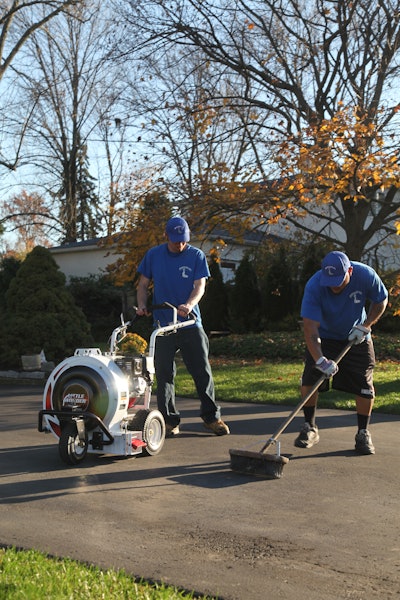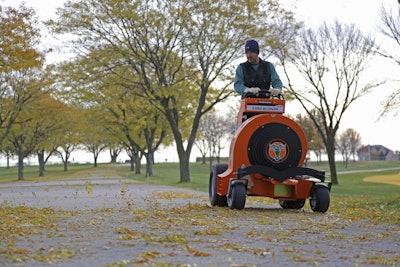
One of the most important steps before sealcoating, striping or any preventative pavement maintenance is cleaning the asphalt. Clearing the edges, cracks, removing oil stains and removing loose debris with a mechanical sweeping machine or blower will help the sealcoating adhere properly to the asphalt pavement. Investing the time and effort to thoroughly clean the pavement will set any maintenance job up for success.
For large parking lots, it is unproductive to use a broom to clean the entire surface. Instead, contractors should invest in blowers, either walk behind or ride on, to improve crew performance and complete more jobs efficiently.
Match the Machine to the Job
Parking lots are designed in all shapes and sizes. Contractors should have a strong understanding of the type of lot they work on to determine the right blower and site preparation equipment.
“It is really determined by the job,” said Carmelo Grenier, senior account manager for Billy Goat. “If it's a big area, then a stand-on blower is the best solution. A stand-on blower will provide the most airflow, have the best maneuverability and one operator can do the job of several workers with backpacks. However, if it's a smaller property, then a walk behind blower does a great job, especially in smaller, hard to reach locations.”
If there are vehicle bollards, islands, large straightaways or hard to reach areas, a mix of equipment could be the plan of action for the crew.
“For instance, if the work area is crowded with obstacles and has wide open areas, the contractor will need to have a mix of equipment available,” said Martin Dain, product manager, Little Wonder. “They may elect to use powerful handheld or backpack blowers to work around the obstacles and a walk behind to address the wide-open areas in an efficient manner. In many cases the walk-behind will handle the bulk of the work.”
Backpack
A backpack style blower allows the operator to aim the nozzle directly at the cracks to blow out all dust, dirt and debris. When choosing a backpack blower, look at Backpack blowers shift the weight of the engine onto your back, distributing it more evenly for operator comfort.STIHL
Backpack blowers shift the weight of the engine onto your back, distributing it more evenly for operator comfort.STIHL
Walk-Behind
Walk-behind or wheeled blowers are effective tools for gathering debris on wide stretches of ground of larger jobs like parking lots. Some models have hand- When considering having multiple machines in the fleet it also means less wear and tear on the operator since the work gets shared across more operators.Little Wonder
When considering having multiple machines in the fleet it also means less wear and tear on the operator since the work gets shared across more operators.Little Wonder
“In areas where there is a large volume of leaf or pine needle debris and the ultimate goal is to remove the debris from the area and not just relocate it, then the combination of a walk-behind blower and a vacuum work well,” said Dain. “When considering purchasing equipment, the number of crews and property sizes will have a significant impact on buying decisions.”
Stand-On
These machines are primarily used for large commercial applications to remove debris with airflow up to 8,000 CFM in some models. Forward and reverse Stand-on blowers makes for quick cleanups and less fatigue.Billy Goat
Stand-on blowers makes for quick cleanups and less fatigue.Billy Goat
“The efficiency and power of a stand-on, (for example with 3,500 to 7,500 CFM) not only makes for quicker work of cleanups, but is far less fatiguing than the time consuming, low productivity of backpack or other blower options,” said Grenier. “Zero-turn models allow for quick maneuvering and versatile bi- or tri- air discharge options afford operators ease of transitioning from left or right blowing.”
Another consideration is the power of the blower or CFM (cubic feet per minute), the volume of air being moved by the machine. A higher CFM is better for a parking lot application because it will allow the machine to cover a wider area over a shorter period of time, increasing productivity, with less labor.
Contractors should also factor in scheduling for jobs and equipment for each crew to utilize.
“Having more than one blower in a fleet improves efficiency because it allows the contractor to either deploy crews to multiple work sites or it can reduce time on one site allowing them to tackle more paying projects in a day,” said Dain. “When considering having multiple machines in the fleet it also means less wear and tear on the operator since the work gets shared across more operators.”
Future of Blowers
Across the country, there has been a shift away from gasoline powered equipment and in some states, the sale of equipment powered by small off-road engines will be regulated by 2024 in an effort to reduce emissions. Some manufactures are exploring battery or alternative fuel powered equipment.
“The future of the industry could also include features related to alternative power sources,” said Dain. “This emphasis on alternate power is driven by environmental regulations surrounding air and noise pollution, supply chain disruption in the combustion engine market, and the desire of users and manufacturers to be more environmentally responsible. All of these have driven the industry to evaluate power sources like electric, propane and diesel-powered equipment for their fleets.”












![Lee Boy Facility 2025 17 Use[16]](https://img.forconstructionpros.com/mindful/acbm/workspaces/default/uploads/2025/09/leeboy-facility-2025-17-use16.AbONDzEzbV.jpg?ar=16%3A9&auto=format%2Ccompress&fit=crop&h=135&q=70&w=240)








